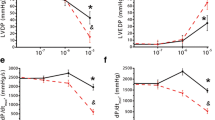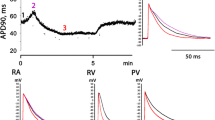Abstract—
Diadenosine polyphosphates (DAP) are now considered as a new class of endogenous regulatory cardiotropic compounds. In previous studies DAP were demonstrated to affect cardiac electrical activity and contractility in various animal species including rats. DAP decreased the action potential duration and reduced the contractility of the rat myocardium. At the same time, DAP did not affect repolarizing potassium currents (IK1, IKACh, Ito1, IKur), which normally participate in repolarization after the action potentials (AP), and had a little effect on L-type calcium current in isolated rat cardiomyocytes. However, in addition to these ionic currents, AP duration can be regulated via chloride currents. In this study the presence of a transient inward calcium-dependent chloride current Ito2 has been shown in rat ventricular myocardium and an influence of DAP on this current has been demonstrated for the first time. Ionic currents were recorded in isolated rat ventricular cardiomyocytes using whole-cell patch clamp method. Action potentials were recorded in isolated preparations of rat right ventricle with sharp glass microelectrodes. In the absence of Na+ and K+ and in the presence of potassium current blockers 4-aminopyridine (5 × 10–3 M) and tetraethylammonium (1.5 × 10–2 M) transient outward current was present in ventricular myocytes. This current was sensitive to non-selective chloride channel blocker 4,4'-diisothiocyano-2,2'-stilbenedisulfonic acid (DIDS, 10–5 M), L-type calcium current blocker nifedipine (10–5 M), and a selective blocker of calcium-dependent chloride channels 6-(1,1-dimethyl ethyl ethyl)-2-[(2-furanyl carbonyl)amino]-4,5,6,7-tetrahydrobenzo[b]thiophen-3 carbonic acid (CaCCinh-A01, 10–5 M). In the presence of diadenosine tetraphosphate (Ap4A, 10–4 M) in the external solution the peak amplitude of the current increased by 44 ± 11%. Diadenosine pentaphosphate (Ap5A) and NAD+ failed to produce any significant effects on the current density. In isolated preparations of rat ventricular myocardium DIDS (10–5 M) and CaCCinh-A01 (10–5 M) blocked the Ap4A-induced acceleration of repolarization. Thus, the effects of Ap4A on cardiac electrical activity in rats are at least partially mediated by its influence on the amplitude of repolarizing chloride current Ito2.



Similar content being viewed by others
REFERENCES
Baxi M.D., Vishwanatha J.K. 1995. Diadenosine polyphosphates: Their biological and pharmacological significance. J. Pharmacol. Toxicol. Methods. 33 (3), 121–128.
Hoyle C.H., Hilderman R.H., Pintor J.J., Schlüter H., King B.F. 2001. Diadenosine polyphosphates as extracellular signal molecules. Drug Dev. Res. 52 (1–2), 260–273.
Mutafova-Yambolieva V.N., Durnin L. 2014. The purinergic neurotransmitter revisited: A single substance or multiple players? Pharmacology & Therapeutics. 144 (2), 162–191.
Flores N.A., Stavrou B.M., Sheridan D.J. 1999. The effects of diadenosine polyphosphates on the cardiovascular system. Cardiovasc. Res. 42, 15–26.
Smyth L.M., Yamboliev I.A., Mutafova-Yambolieva V.N. 2009. N-type and P/Q-type calcium channels regulate differentially the release of noradrenaline, ATP and β‑NAD in blood vessels. Neuropharmacology. 56 (2), 368–378.
Pustovit K.B., Kuzmin V.S., Sukhova G.S. 2014. The influence of extracellular NAD+ on contractile and bioelectrical activity of rat heart. Ros. Fiziol. Zhurnal im. Sechenova (Rus.). 100 (4), 445–457.
Pakhomov N.V., Pustovit K.B., Abramochkin D.V., Kuzmin V.S. 2017. The role of diadenosine pentaphosphate and nicotinamide adenine dinucleotide (NAD+) as potential nucleotide comediators in the adrenergic regulation of cardiac function. Neurochem. J. 11 (1), 63–71.
Steinmetz M., Schlatter E., Boudier H.A.J.S., Rahn K.H., De Mey J.G.R. 2000. Diadenosine polyphosphates cause contraction and relaxation in isolated rat resistance arteries. J. Pharmacol. Exp. Ther. 294 (3), 1175–1181.
Pustovit K.B., Ivanova A.D., Kuz’min V.S. 2018. Extracellular NAD+ suppresses adrenergic effects in the atrial myocardium of rats during the early postnatal ontogeny. Bull. Eksp. Biol. Med. (Rus.). 165, 4–8.
Pustovit K.B., Potekhina V.M., Pakhomov, N.V., Kuzmin, V.S. 2018. The effects of extracellular diadenosinetetraphosphate on the bioelectrical activity of atrial and ventricular rat myocardium at early stages of postnatal ontogeny. Vestnik Moskovskogo Univ. Seria 16, Biologia (Rus.). 73 (1), 52–59.
Pustovit K.B., Kuzmin V.S., Abramochkin D.V. 2016. Diadenosine tetra- and pentaphosphates affect contractility and bioelectrical activity in the rat heart via P2 purinergic receptors. Naunyn Schmiedebergs Arch. Pharmacol. 389 (3), 303–313.
Abramochkin D.V., Pustovit K.B., Filatova T.S. 2015. Effects of diadenosine polyphosphates on inward rectifier potassium currents in rat cardiomyocytes.Vestnik Moskovskogo Univ. Seria 16, Biologia (Rus.). 70 (4), 153–157.
Kuzmin V.S., Pustovit K.B. 2016. Effekty i mekhanizmy deistvia diadenozinovykh polifosfatov i ikh proizvodnykh v serdtse mlekopitayushchikh (Effects and mechanisms of action of diadenosine polyphosphates and their derivatives in mammalian heart). Moscow: Universitetskaya kniga.
Kuzmin V.S., Rosenstrauch L.V. 2010. The ionic mechanisms of action of class III antiarrhytmic drugs. Kardiologia (Rus.). 7, 49–61.
Bokeria O.L., Akhobekov A.A. 2014. Ionic channels and their role in the development of cardiac arrhythmias. Annaly Aritmologii (Rus.). 11 (3), 176–184.
Hiraoka M., Kawano S., Hirano Y., Furukawa T. 1998. Role of cardiac chloride currents in changes in action potential characteristics and arrhythmias. Cardiovasc. Res. 40, 23–33.
Zygmunt A.C., Gibbons W. 1992. Properties of the calcium-activated chloride current in heart. J. Gen. Physiol. 99 (3), 391–414.
Xu Y., Dong P.H., Zhang Z., Ahmed G.U., Chiamvimonvat N. 2002. Presence of a calcium-activated chloride current in mouse ventricular myocytes. Am. J. Physiol. Heart. Circ. Physiol. 283, H302–H314.
Isenberg G., Klockner U. 1982. Calcium tolerant ventricular myocytes prepared by preincubation in a “KB medium”. Pflugers Arch. 395 (1), 6–18.
Ye Z., Wu M.M., Wang C.Y., Li Y.C., Gong Y.F., Zhang J., Wang Q.S., Song B.L., Yu K., Hartzell H.C., Duan D.D., Zhao D., Zhang Z.R. 2015. Characterization of cardiac anoctamin1 Ca2+-activated chloride channels and functional role in ischemia-induced arrhythmias. J. Cell Physiol. 230 (2), 337–346.
Pogorelov A., Pogorelova V., Pogorelova M. 2010. Does an electroneutral K+/Cl− antiport occur in cardiomyocyte during acute ischemia? Biophysics. 55 (5), 771–774.
Abramochkin D.V., Borodinova A.A., Nikolsky E.E., Rosenstrauch L.V. 2012. Modulation of non-quantum acetylcholine secretion by nitric oxide in the myocardium of rat right atrium. Biol. Membrany (Rus.). 29 (5), 317–323. (English version: Nitric oxide modulates intensity of non-quantal acetylcholine release in myocardium of the right atrium of rat. Biochemistry (Moscow) Suppl. Series A. 6 (4) 288–293).
Pakhomov N., Pustovit K., Potekhina V., Filatova T., Kuzmin V., Abramochkin D. 2018. Negative inotropic effects of diadenosine tetraphosphate are mediated by protein kinase C and phosphodiesterases stimulation in the rat heart. Eur. J. Pharmacol. 820, 97–105.
Oudit G.Y., Kassiri Z., Sah R., Ramirez R.J., Zobel C., Backx P.H. 2001. The molecular physiology of the cardiac transient outward potassium current (Ito) in normal and diseased myocardium. J. Mol. Cell Cardiol. 33 (5), 851–872.
Liu Y., Zhang H., Huang D., Qi J., Xu J., Gao H., Du X., Gamper N., Zhang H. 2015. Characterization of the effects of Cl– channel modulators on TMEM16A and bestrophin-1 Ca2+ activated Cl– channels. Pflugers Arch. 467 (7), 1417–1430.
Cho H., Oh U. 2013. Anoctamin 1 mediates thermal pain as a heat sensor. Curr. Neuropharmacol. 11 (6), 641–651.
Eggermont J. 2004. Calcium-activated chloride channels: (Un)known, (un)loved? Proc. Am. Thorac. Soc. 1 (1), 22–27.
Tian Y., Schreiber R., Kunzelmann K. 2012. Anoctamins are a family of Ca2+-activated Cl– channels. J. Cell Sci. 125 (Pt 21), 4991–4998.
Pedemonte N., Galietta L.J. 2014. Structure and function of TMEM16 proteins (anoctamins). Physiol. Rev. 94 (2), 419–459.
Horvath, B., Vaczi K., Hegyi B., Gonczi M., Dienes B., Kistamas K., Banyasz T., Magyar J., Baczko I., Varro A., Seprenyi G., Csernoch L., Nanasi P.P., Szentandrassy N. 2016. Sarcolemmal Ca2+ entry through L-type Ca2+ channels controls the profile of Ca2+-activated Cl– current in canine ventricular myocytes. J. Mol. Cell Cardiol. 97, 125–139.
O’Driscoll K.E., Hatton W.J., Burkin H.R., Leblanc N., Britton F.C. 2008. Expression, localization, and functional properties of Bestrophin 3 channel isolated from mouse heart. Am. J. Physiol. Cell Physiol. 295 (6), C1610–C1624.
O’Driscoll K.E., Leblanc N., Hatton W.J., Britton F.C. 2009. Functional properties of murine bestrophin 1 channel. Biochem. Biophys. Res. Commun. 384 (4), 476–481.
Pustovit K.B., Abramochkin D.V. 2016. Effects of nicotinamide adenine dinucleotide (NAD+) and diadenosine tetraphosphate (Ap4A) on electrical activity of working and pacemaker atrial myocardium in guinea pigs. Bull. Exp. Biol. Med. 160 (6), 733–736.
Erlinge D., Burnstock G. 2008. P2 receptors in cardiovascular regulation and disease. Purinergic Signal. 4 (1), 1–20.
Buvinic S., Briones R. Huidobro-Toro J.P. 2002. P2Y1 and P2Y2 receptors are coupled to the NO/cGMP pathway to vasodilate the rat arterial mesenteric bed. Br. J. Pharmacol. 136 (6), 847–856.
Erb L., Weisman G.A. 2012. Coupling of P2Y receptors to G proteins and other signaling pathways. Wiley Interdiscip. Rev. Membr. Transp. Signal. 1 (6), 789–803.
Mitchell C., Syed N.I.H., Gurney A.M., Kennedy C. 2012. A Ca2+-dependent chloride current and Ca2+ influx via Cav1.2 ion channels play major roles in P2Y receptor-mediated pulmonary vasoconstriction. Br. J. Pharmacol. 166 (4), 1503–1512.
Rajagopal, M., Kathpalia P.P., Thomas S.V., Pao A.C. 2011. Activation of P2Y1 and P2Y2 receptors induces chloride secretion via calcium-activated chloride channels in kidney inner medullary collecting duct cells. Am. J. Physiol. Renal Physiol. 301 (3), F544–F553.
Author information
Authors and Affiliations
Corresponding author
Additional information
Translated by T. Filatova
Abbreviations: AP, action potential; DAP, diadenosine polyphosphates; TEA, tetraethylammonium; 4-AP, 4-aminopyridine.
Rights and permissions
About this article
Cite this article
Filatova, T.S., Abramochkin, D.V. Purinergic Regulation of Transient Calcium-Dependent Chloride Current Ito2 in Rat Ventricular Myocardium. Biochem. Moscow Suppl. Ser. A 13, 147–154 (2019). https://doi.org/10.1134/S1990747818060041
Received:
Revised:
Accepted:
Published:
Issue Date:
DOI: https://doi.org/10.1134/S1990747818060041




